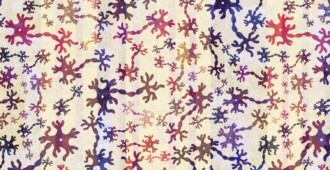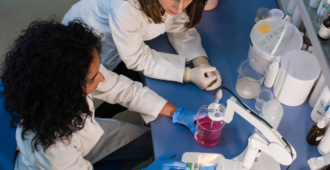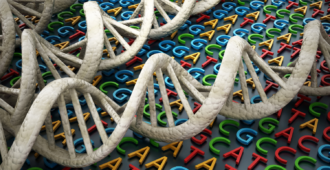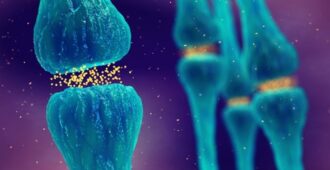Much like fictional superheroes who are dedicated to protecting the vulnerable with their supernatural abilities, a newly discovered class of ‘Hero’ proteins with unusual properties can prevent toxic protein aggregation seen in several neurodegenerative disorders, such as MND. This finding may have potential for new treatments and applications in biotechnology.
In a study recently published in the journal PLOS Biology, researchers at the University of Tokyo, Japan, have reported remarkable properties in a group of proteins called Hero (or heat-resistant obscure) proteins that are found in both humans and flies.
Vulnerable proteins

Much of our bodies are built from proteins which we rely on for most of our biological functions to work properly. These proteins are made up of long chains of special building blocks (called amino acids). The long chains of amino acids must be put together and folded in a precise and specific way to form a rigid structure that is held in place with weak attractions between the individual amino acids. This is because the activity of proteins is largely dependent on their formed shape.
Imagine building a flat-packed chair from IKEA – if pieces are not put together correctly, it’s not a functional chair and could even be dangerous to sit on.
Once formed, several things can affect the way the protein maintains its shape, and so alter the efficiency of its function. For example, if the temperature of a protein’s environment is excessively changed from normal, or if it is exposed to chemicals, the chemical attractions between the amino acids can be disrupted, causing most proteins to lose its 3D structure (denature) and/or clump together (aggregate). This usually stops the protein from working.
Temperatures close to the boiling point of water can irreversibly destroy the structure of proteins. An everyday example of this can be seen in your kitchen with a fried egg. Albumin protein in the liquid egg white becomes opaque and solid as it is loses its structure by heat. It won’t return to its original raw-egg state even when cooled down.
Organisms have a set of proteins called ‘chaperones’. As the name suggests, these proteins ‘look after’ other proteins to maintain their shape and function in times of stress. Chaperone proteins use cellular energy, in the form of ATP, to either refold or dispose of misfolded proteins. But as these are proteins themselves, they can also stop working when exposed to stresses.
A Hero in disguise…
Previously, the only known organisms to endure harsh conditions, such as high temperature or high salt concentrations, were those living in extreme environments, called extremophiles. They had evolved to protect their functional proteins, such as heat-loving (thermophilic) bacteria.
Even between different species, proteins with similar functions usually have similar amino acid sequences, called evolutionary conservation. But there is something different about Hero proteins…
The identification of Hero proteins was somewhat accidental around 2011 when a graduate student, Shintaro Iwasaki, encountered an unusually heat-resistant protein in fruit flies (Drosophila) that increased the stability of another protein, Argonaute (the protein at focus in the lab’s studies).
“…its biological relevance was unclear and, moreover, the protein’s sequence seemed unrelated to anything else,” said Yukihide Tomari, who heads the University of Tokyo lab and is co-corresponding the published paper. “So, we didn’t know what to do next and just decided to put it on the shelf until years later.”
Are there more Heroes out there?
To try and identify additional Hero proteins, the team at the University of Tokyo obtained extracts from lab-grown human cells and fruit fly cells, then simply boiled them. High temperatures would normally weaken the chemical interactions that support a protein’s structure and cause it to unfold and clump together with other unfolded proteins. But this didn’t happen with the Hero proteins.
The researchers used an analytic technique called mass spectrometry to identify any proteins that remained in the test tubes after boiling. This found hundreds of Hero proteins.
Interestingly, while most proteins have a rigid 3D structure, the newly identified Hero proteins had a long, flexible string-like structure with a high affinity for water (hydrophilic) and an unusually large amount of positive charges. They also had high levels of “intrinsically disordered regions” which are regions that don’t fold into any specific shape. These features most likely allow the Hero proteins to drape other proteins like a shield, protecting them from misfolding.
The team selected six of these proteins to study in detail. When some of these were mixed with other “client” proteins, the clients kept their shape and function despite being in contact with high heat or harsh chemicals that would normally destroy them (Figure 1).

Coming to the rescue…
Protein aggregation and misfolding also occurs in several neurodegenerative diseases such as MND, Huntingdon’s and Alzheimer’s. Prompted by the initial experimental results, the researchers tested if Hero proteins could prevent the toxic build-up of disease-related protein clumps in cells.
In nearly all cases of MND, changes to the TDP-43 protein causes the protein to misfold and form aggregate in nerve cells that control voluntary muscle movement (motor neurons).
In experiments using lab-grown human motor neuron cells, Hero proteins reduced misfolding and blocked the formation of TDP-43 protein clumps – a hallmark of MND – and GA50, a protein produced by the C9orf72 gene, the most commonly mutated MND gene. In a fruit fly model of MND, Hero proteins reduced neuronal dysfunction caused by TDP-43. The team’s work also showed that high levels of Hero proteins extended the lifespan of fruit flies by 30%.
Is there a ‘SuperHero’ among us?
Kotaro Tsuboyama, lead author of the study, commented, “We saw many positive effects, but so far, we did not find a ‘superhero’ among those six Hero proteins that can stabilise all client proteins. Some Hero proteins are good for some clients (proteins), and others are good for other clients (proteins).”
Each Hero protein is likely to deal with many different client proteins. Researchers are now planning future experiments to identify any patterns to see which Hero proteins assist which client proteins in living organisms. To do this, there will need to be a combination of different approaches, including genetics, biochemistry, and biophysics.
Protein instability is often linked to diseases, especially neurodegenerative disorders. This study reveals that organisms naturally use Hero (heat-resistant obscure) proteins as ‘shields’ to stabilise the functions of other proteins. Their remarkable properties allow them to protect proteins from clumping together (aggregating) or losing their shape (denaturing). The researchers also found Hero proteins to efficiently block the build-up of pathogenic aggregates in cell and fly models of neurodegenerative diseases.
Can we count on Hero proteins to protect motor neurons from toxic TDP-43 aggregation in MND? The study highlights a starting point for Hero proteins to be used in future development of therapeutics or diagnostic methods for people with MND.
Tsuboyama K, Osaki T, Matsuura-Suzuki E, Kozuka-Hata H, Okada Y, Oyama M, et al. (2020). A widespread family of heat-resistant obscure (Hero) proteins protect against protein instability and aggregation. PLoS Biol 18(3): e3000632. https://doi.org/10.1371/journal.pbio.3000632







You mention proteins folding in a certain way to give us the correct functioning of our bodies. You may be interested to known there used to be a game called FINDIT. The purpose of this game was to fold a protein displayed on the screen. With practice you could become quite good at folding these proteins. After even more practice you could then move to more “serious” projects. Last time I looked it was still running. Malcolm
Hi Malcolm,
Thanks for reading the blog post and for your interesting comment.
I’ve just had a look for the game and do you mean FOLDIT? As well as being an educational game, it’s fascinating to see that there have been a number of scientific publications on the use of this computer game to contribute to important scientific research, such as designing new proteins that could help prevent or treat important diseases. Thanks for bringing this to my attention!
Kind regards,
Riddhi
Research Development Team